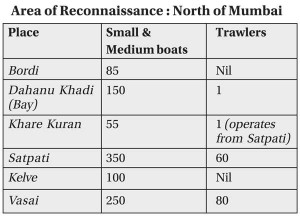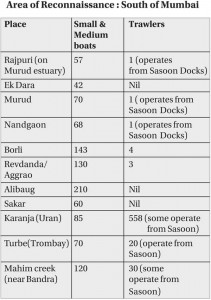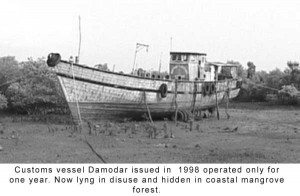Revamping Coastal Security Apparatus: Considering the inadequate coastal security infrastructure along the vast and porous Indian coastline the issues relating to registration of boats, transponders and bio-metric identity cards for fishermen, port workers and others associated with maritime activities assume tremendous urgency. With maritime terrorism actually becoming a reality, security agencies have observed that there are several fishing harbours in India that are operational within port limits. Clearly these fishing harbours could be misused by maritime terrorists and, therefore, a clear plan of action must be enunciated to relocate such fishing harbours, taking due cognizance of the livelihood issues of the fishermen and ensuring that they are not adversely affected.
Also read: Gaps in Maritime Security-I
 While these are issues that the Indian government is keen to address in the most effective and time bound manner, much will be achieved if a ‘mission mode’ work ethic is infused to ensure that the Indian national security establishment is in a position to deter the most sophisticated maritime terrorist attack of the future.
While these are issues that the Indian government is keen to address in the most effective and time bound manner, much will be achieved if a ‘mission mode’ work ethic is infused to ensure that the Indian national security establishment is in a position to deter the most sophisticated maritime terrorist attack of the future.
A hallmark ground survey carried out by this author and his team of investigators three years ago is still relevant because nothing has changed on the ground. In addition to the status quo, what the rough survey does reveal is the massive task at hand when it comes to revamping coastal security. The survey randomly selected certain fishing harbours along the Konkan coast in Western India.
Most of these places are small centres of fishing, barring Dahanu Khadi, Satpati, and Vasai where trawlers are available. Of these Dhanu Khadi is the smallest, rural place, where people are a little more simplistic, and not as suspicious and street smart as the people in Vasai and Satpati.
Other places like Bordi, Khare Kuran, Kelve, do not have trawlers, they have smaller, diesel engine boats, which use more traditional floating net methods of catching fish. Their boats are not that powerful, but these also go outside Indian territorial waters.
(There are many more fishing villages along this section of the coast but the above fishing centres were visited for the purpose of the survey)
Murud – Janjira (Estuary) Area
- The Murud- Janjira estuary is a deep estuary (at least 10 km deep) with several villages around it. Still it is quite isolated with long stretches where one could not see a soul for miles. Fishing societies affirm that they are rarely checked. Patrolling rarely happens along this stretch.
- The local Customs ’speed boat’ is actually a normal medium boat commissioned in 1998, but rotting in a mangrove near Agardanada (close to the mouth of the estuary).
Revdanda, Kashid, Nandgaon
- From Nandgaon, to Kasid, the population along the seafront is extremely sparse. The beaches are extremely rocky and the few fishing villages are in small estuaries / bays.
With well armed Somali pirates wreaking havoc on shipping lanes from the Indian Ocean to the Gulf of Aden between Somalia and Yemen, Al Qaeda and its associate terror groups could easily outsource maritime terrorism to mercenary pirate groups.
- Revdanda is a big fishing center along the Kundalika river. There are several fishing villages along the coast and the mouth of the river.
- The Customs has a major office with the Superintendent of Customs stationed there.
- Revdanada is also the base all patrol boats of the Raigad district police. In 2004 three new Patrol boats were purchased for patrolling the coastal waters. But instead of placing them at three different places and evenly distributing jurisdiction between the three all the boast are based in Revdanda. But with no dedicated staff these boats have become inoperable and are rotting in the mangroves.
- There is a private (commercial jetty) in the middle of the river Kundalika, owned by the Vikram Ispat Co. (Grasim Group). Large ships carrying iron ore dock there and unload there consignment, which is then transported by conveyor belt to the plant a kilometer upstream.
Alibaug – Sakar Area
- The Alibaug Sakar area is more active in terms of number of boats. The beaches here are very flat, but most boats here are small 2 / 3 cylinder engine boats.
- The two Customs offices in this area are literally non-functional. Two years ago both were locked and in dilapidated condition. Fishermen say that the Customs staff work half a day and then disappear. They hardly check the fishing cargo unloaded at the Alibaug-Sakar stretch. The police presence in this entire region from Murud to Alibaug is very minimal.
Karanja (Uran)
- Uran is just across Thane creek from Colaba. Uran is also where, JNPT (Jawahar Lal Nehru Port Trust) is situated. And the Oil/ Gas jetties of ONGC are in Nahva-Sheva.
- Karanja is the biggest fishing centre in all of Maharashtra. A lot of the trawlers operate out of the Sasoon docks in Mumbai. There is little local police presence in Karanja itself.
- There is a large Customs office in Mora (6 km from Karanja), which has recently switched to a computerized database management system. As a result all boats which operate out of this area now have numbers like (F/MOR/04/xx) earlier they were just KRJ (meaning the boat is registered in Karanja) or URN(meaning the boat is registered in Uran)
- There is a small sub-inlet off Thane creek, called Panvel creek (along Vashi/ Navi Mumbai). Here the Central Railway is building a new line and a bridge. Huge barges carrying sand sail in and offload in the area. The Ambuja Group has a jetty on Panvel creek and there is one Customs patrol vessel stationed here.
Trombay Area: (Turbhe)
- Trombay is where some extremely important Defence/ Government institutions are located (right on the coast), among these are the:
– The Bhaba Atomic Research Centre (BARC)
– The Trombay Refinery
– The Rashtriya Chemicals and Fertilisers (RCF)
The CISF is tasked with security of all these institutions and the Navy looks after its own armoury. But this security presence is restricted in the sense that it is confined to guarding installations and compounds. Instead as Mumbai 26/11 has shown terrorists with marine commando training and operating in small groups need to be countered with a holistic security strategy. Currently outside the installations and such important institutional compounds there is no other security in the area barring few Mumbai police constables on the road turning into BARC.
- The Customs has an office in Trombay, but it is not very active.
- The trawler/fishing boat/ small boats traffic along the Thane creek is quite high. A lot of passenger ferries operate out of the Gateway of India too.
The Sassoon Dock Area
- This is the main Fishing Docks of Mumbai, and Maharashtra. For years the security has been lax at the docks. This is where the Mumbai 26/11 terrorists docked absolutely unhindered. Usually there is only one Port Authority guard at the entrance of the docks. But on most occasions the guard on duty is missing from the post.
- Only Trawlers operate out of the Sassoon dock.
- The dock area is extremely crowded and it is easy to get lost in the crowds especially at high tide. So it is not surprising that the 10 Mumbai 26/11 came ashore without attracting much attention and smoothly made their way into South Mumbai.
- The Sassoon dock is situated in the heart of the defence area of Mumbai (Colaba), and is close to the Naval base.
- There is no special police presence either on the ground at the docks or in patrol boats around Sassoon docks.
Assessment of Security
On the basis of this survey one can conclude that the security cover is fragile. Here is a dissection of the coastal security along a section of a sensitive coastal area on India’s west coast. It can be categorised into five different levels:
- The Fishing Co-operative
- The Customs Department
- The Local Police
- The Indian Coast Guard
- The Indian Navy
The Fishing Co-operative Society
Each centre no matter how small, has atleast one or two fishing co-operative societies.
- Every boat has a registration number. (For example the boats in a small place like Bordi are registered in Umergaon in Gujarat. Their numbers begin with UMR. Boats in Dahanu, numbers begin with DNU). But these registration numbers are not computerized and cannot easily be tracked or regulated through ‘know the boat owner’ profiling.
The concepts of Indian territorial waters (12 Nautical Miles from the coast), Exclusive Economic Zone (200 Nautical Miles from the coast) and high seas are not understood clearly not only by fishermen, but glaringly also by local policemen and Customs staff. Fishermen have often spotted large foreign mechanized trawlers fishing in Indias EEZ and sometimes even in territorial waters.
- All boats, have complicated system of recognition by the flags they fly, which are understandable only to the locals. Some boats belonging to one family will have additional flags of the family. (So confusing that even the Coast Guard or the Customs don’t understand it.)
Bottom line: No written rules on flag flying.
- Technically the crew of the boat cannot change. The boat has to carry papers, issued by the Society countersigned by Customs, each time it goes out to sea. But this rule is often breached. The Pass (Photopass as it is called in the local lingo) has photos of the entire crew of the boat, and is issued once for the entire season, beginning End of August to the End of May. Anyone else travelling on the boat, strict No-No.
Bottom Line: Everyone has a photopass of the entire crew. While the rule exists, it is hardly implemented either in law or in spirit. In fact, this is a much abused system and one can bribe the society to make as many photo-passes as possible.
- The only place where the crew can get diesel is the Society, which in turn directly gets it from government companies like BP, HP IBP. Thus each time a boat has to go out, the Society gets to know. The fishermen are given diesel at a subsidised rate, but recently to prevent illegal supply to other places, the government has asked Societies to buy diesel at the normal rate, and at the end of each quarter, the oil companies give back the payment to the society.
Bottom Line: Essentially a boat can be easily registered with a fishing harbour, a photo pass for its crew can again be easily issued and even fuel can be purchased without arousing any suspicion.
- There is nothing to stop a boat from procuring diesel from outside, but Societies, even large ones are very tightly knit, and an unscheduled movement will definitely be noticed. But local police intelligence and Customs offices hardly interact with fishing Societies to gather human intelligence. Most boats go out together to sea and come back together. They will normally move within line of sight, and normally stay close together at high seas.
Bottom Line: Maritime terrorists can easily infiltrate this system and the only way to prevent this is to involve and co-opt fishing societies and fishermen in the massive task of securing the coastline.
- Most Societies have wireless sets. Most large trawlers (nearly 80%) and many medium boats have wireless VHF sets, and Global Positioning System equipment on board. So Societies can track movements of boats through wireless.
Bottom Line: Societies know where the boat is and what it is doing. This communication network should be linked to coastal police stations proposed to be set up along the coast.
- The concepts of Indian territorial waters (12 Nautical Miles from the coast), Exclusive Economic Zone (200 Nautical Miles from the coast) and high seas are not understood clearly not only by fishermen, but glaringly also by local policemen and Customs staff. Fishermen have often spotted large foreign mechanized trawlers fishing in India’s EEZ and sometimes even in territorial waters. Surely the communication systems on the Indian fishing trawlers can be networked to listening posts of Coast Guard and the coastal police stations, so that millions of Indian fishermen can become the eyes and ears of the Indian security establishment in the high seas and coastal areas.
The Fishing Co-operative (Machchimar Sahakari Sansthan) must become a crucial element of coastal security related activities. At the moment the Fishing Cooperative and the fishing communities across the eastern and western coasts do not have any linkage with Customs or police. Intelligence agencies hardly have any penetration in these communities. Also a major drawback is that the movement of boats from fishing harbours, jetties and other landing points on the coast is unrestricted, so its easy for a boat to either come in or sail out.







It seems, that the Mumbai bomb blasts in 1992, happened when Dawood Ibrahim was making his business interests legitimate in Mumbai, as liberalization was happening. Smuggling was becoming less of a crime, due to easing of restrictions. Before 26/11, there was no reason for anyone to believe that any militant group would have an interest in India, for subversion.
What the U. S. observed, was that groups were attacking U. S. ships and installations, and were claiming to be Al Qaeda. There was no seeming communication between Al Qaeda and these people. The conclusion was, that any group or individual was attacking U. S. interests and mentioning that they belonged to Al Qaeda. Apparently, when President George W. Bush declared the war on terror, he had this state of affairs in mind.
There was not enhanced need to patrol the coast of Mumbai, before 1992, but less of it. 26/11 was not supposed to have been even to imagination. It seems, small groups of people with a capability not available before, can do any mayhem. Pakistan had occurrences of bomb blasts carried out randomly in that nation. There are reports of training camps of militants in Pakistan, but people can learn to shoot in firing ranges, can be physically fit in training processes, and can even learn about almost anything that they would want to. It could seem, that 26/11 was such a group of people. No militant group abroad had any interest in India. The term, ‘Major Iqbal’ might be a ruse of such a group. Also, Dawood Ibrahim has family living in Mumbai, today. And his associates before he went to Karachi.
India has a 3 million army for a great population number. The U. S. has a much smaller number. Since the regular army needs a certain deployment procedure that is costly, they use special forces to combat small groups. The U. S. SEAL team 6 is an elite group, but the combat that took place didn’t have exchange of fire on a great scale, when Osama was killed.